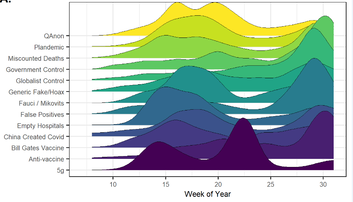 I am sure you have read the news about how a variety of COVID-19 conspiracy theories have persuaded many people that the pandemic is a fake and manipulative scam, possibly involving a disease no more harmless than flu. Or the ones saying it is a deadly attack weapon designed by some secretive perpetrator. Maybe you have also thought about how this is a modern phenomenon, driven by domestic and foreign manipulators exploiting the easy access to social media. And surely you have felt sorry for the people who believed that Covid was harmless and ended up sick because they failed to protect themselves. But this story is only half true. The pandemic is new and the specific conspiracy theories are new, but conspiracy theories of various kinds are a permanent feature of our society. People share variations of them in face-to-face conversations, in writing, and now also on social media. Who are these people spreading conspiracy theories? Why do they do it? In research published in American Sociological Review, these issues are explored by Hayagreeva Rao, Paul Vicinanza, Echo Zhou,and me. Conspiracy theories make threats more understandable, and thereby give a feeling of mastery and control. This may seem ironic because conspiracy theories always involve some hidden plot by secretive perpetrators. That’s exactly the point though. The conspiracy theorist is the one who can see through the concealment and understand the plot. And sometimes the plot means that the apparent danger is not real (the scam disease). Even when the danger is real (the disease as weapon), some people will find the thought of a human attacker more comfortable than that of a mindless virus feeding on people to reproduce itself. How do we know that conspiracy theories help people cope with the pandemic threat? Simple. One of the drivers of social media Covid conspiracy talk was the infection rate. More infection, more conspiracy theory talk. Conspiracy theories counter threat and reduce fear. Conspiracy theories have moderate and extreme versions. This is easy to tell by looking at their content. The “film your hospital” conspiracy theory was about hospitals pretending to be filled with patients (for money, or for political reasons). This is moderate. An example extreme version is Bill Gates orchestrating the pandemic for various evil purposes. Another is Covid being a way of controlling people while constructing malicious 5G towers. Why does it matter that the conspiracy theories differ in how extreme they are? Simple, again. One of the drivers of social media Covid conspiracy talk is that the moderate versions are gateways that get people into conspiracy talk. Later many of them graduate to extreme versions. Conspiracy theorists can spread different conspiracy theories, often at the same time. And remarkably, often conspiracy theories that contradict each other. Logically, Covid can’t both be a harmless scam and a deadly weapon, but the same people would spread both within the span of a week (and yes, these were people, not bots – we can identify bots). How to make sense of this? Maybe the best way to sum it up is that conspiracy theories are a form of reality denial. When the reality is threatening and difficult to explain and rationalize, as it is during a pandemic, a conspiracy theory offers an escape. But the escape is not perfect, because our society is full of people who don’t believe in conspiracy theories and will challenge the believers. That’s why some poeple have multiple conspiracy theories. Whenever one of them is challenged, the conspiracy theorist can fall back on another. What to do about such reality denial? The starting point must be that it is not simple ignorance. Reality denial is motivated reasoning, and facts alone will not help. Explain how one conspiracy theorist is false, and the conspiracy theorist will fall back on another. Because it is motivated by a wish to reduce and control threat, the solution always involves explanation of how the threat can be reduced through human action. It is a difficult conversation because masks, isolation, and vaccinations all have this effect, but conspiracy talk does not go away unless we explain how the threat can be reduced through joint action such as vaccinations and personal caution. Greve, H. R., Rao, H., Vicinanza, P., & Zhou, E. Y. (2022). Online Conspiracy Groups: Micro-Bloggers, Bots, and Coronavirus Conspiracy Talk on Twitter. American Sociological Review, forthcoming. https://doi.org/10.1177/00031224221125937 Comments are closed.
|
Blog's objectiveThis blog is devoted to discussions of how events in the news illustrate organizational research and can be explained by organizational theory. It is only updated when I have time to spare. Archives
May 2024
Categories |
 RSS Feed
RSS Feed